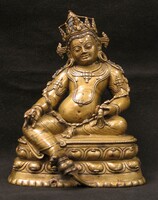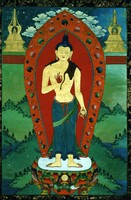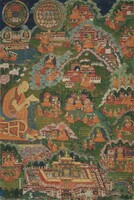Gyurme Dechen Illuminations

The images found on this gallery page are twelve illuminations from volume two [gsung 'bum 'gyur med bde chen, WA. TBRC P644] of the collected works of Lochen Gyurme Dechen ('gyur me bde chen). He is most famous for writing the biography of Tang Tong Gyalpo who is credited with founding the Chagzampa Tradition of the Shangpa Kagyu to which Gyurme Dechen was closely associated. Four of the illuminations depict Gyurme Dechen, numbers #3, 4, 9 and 11.
The illuminations below use two types of script, Lantsha and Tibetan, and two languages, Sanskrit and Tibetan. Some of the Lantsha letters are very difficult to read and appear to be slightly Vartu script in execution because of the hand-writing style. Illuminations numbered #1 through 4 and #11 use Lantsha script. Illuminations #5 through 10 use Tibetan script. (For the written scripts used in Tibetan religious texts see the website Indian Scripts in Tibet).
Inscriptions:
1. Nama shri kalachakraya (dpal dus kyi 'khor)
2. Nama Kalki vijaya sukirtiya (rigs ldan rnam rgyal grags pa bzang po)
3. Nama akshara mahasukhaya ('gyur med bde chen)
4. Nama akshara mahasukhaya ('gyur med bde chen)
5. Om Ah niguma nama (om A ni gu ma)
6. Om Ah virya bhadra nama (Om A brtson 'grus bzang po)
7. Om Ah Vajradhara nama (Om A rdo rje 'chang)
8. Punya sagara, Punya dhvaja nama (khrus khang bsod nams rgya mtsho)
9. Gyurme Dechen and Kunga Drolchog (Lo chen 'gryur med rdo rje dang kun dga' gro mchog)
10. Shadbhuja Mahakala (Phyag drug ye shes mgon po)
11. Nama akshara mahasukhaya ('gyur med bde chen)
12. [the final illumination has no inscription - Amitayus Buddha]
- Illumination #5,6,7, and 8 are written with Tibetan letters using Sanskrit names for Niguma, Virya Bhadra, Vajradhara, Punya Sagara and Punya Dhvaja.
- The second name in illumination #8, Punya dhvaja, has not yet been identified with a Tibetan figure.
- The names in illuminations #9 and #10 are written with Tibetan letters using Tibetan names.
- The final illumination, #12, has no inscription.
A number of the names on the illuminations have been identified based on the various names with which Dechen Gyurme signed his miscellaneous works, or the names of individuals mentioned in the volume two compilation text.



















